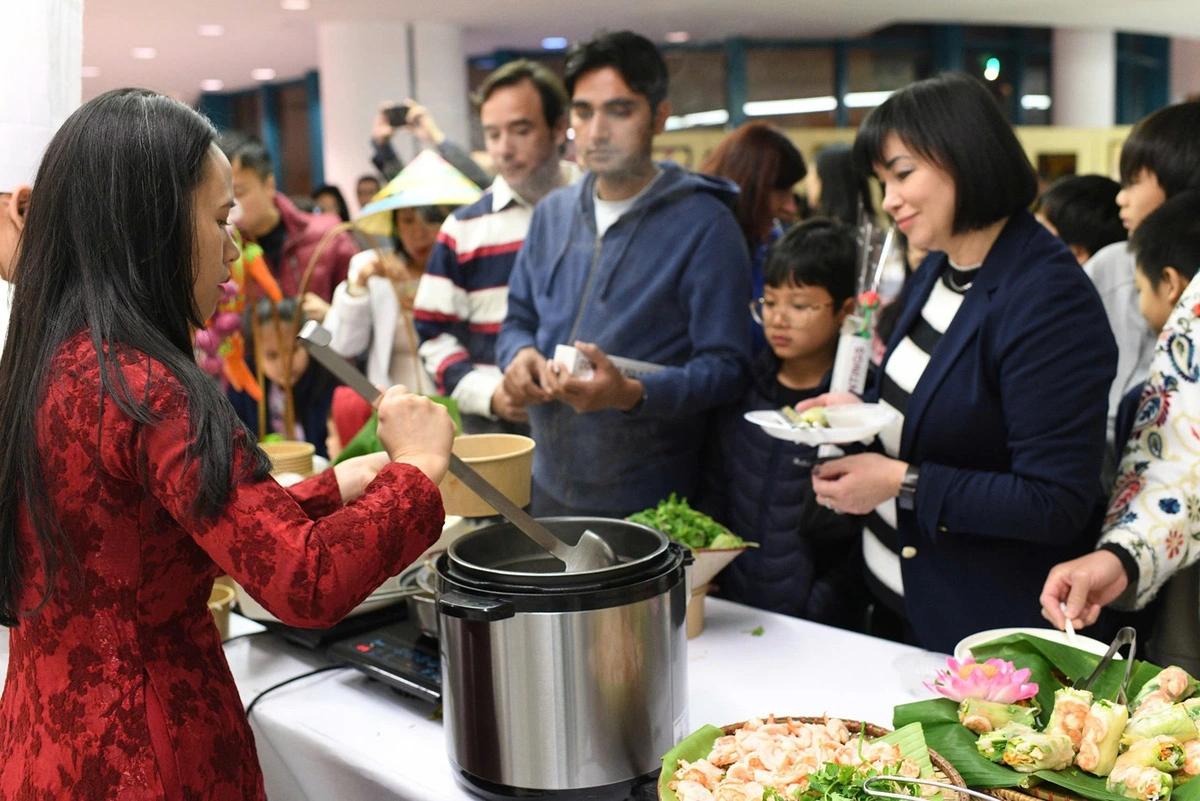Chuon Ngo is a traditional nacre inlay village in Hanoi’s Phu Xuyen District with a rich history dating back centuries. One unique aspect of their products is the seamless integration of mother-of-pearl pieces into wooden surfaces, resulting in flat inlays with exquisite lines.
The artisans in Chuon Ngo are known for their meticulous attention to detail.
| The Phoenix motif on the Chuon Ngo mother-of-pearl mosaic. Photo: Luu Viet Thang |
In the peaceful days leading up to the end of the year, the village of Chuon Ngo comes alive with the sounds of chiseling and sawing in traditional mother-of-pearl inlay workshops. Artisan Pham Van Bac, who started learning the craft at the young age of 12, now boasts over 50 years of experience.
The craft of mother-of-pearl inlay requires great effort and precision. Bac’s process typically involves five stages, including sketching the shapes on a wooden surface, cutting the mother-of-pearl according to the design, carving the shapes into the surface, embedding the nacre pieces, and polishing the surface to accentuate the pattern.
According to renowned artisan Pham Van Bac of Chuon Ngo Nacre Inlay Village in Hanoi’s Phu Xuyen District, advancements in machinery have streamlined and simplified the process of creating mother-of-pearl mosaics in the village.
“In the past, artisans had to slice mussel shells along the grain, resulting in only thin layers being removed. With modern machines, shells are cut along the curvature, producing flat and smooth mother-of-pearl pieces of varying sizes,” he explained.
| The stage of drawing patterns on mother-of-pearl. Photo: Lang nghe Kham trai Chuon Ngo |
Artisan Dao Thi Toan from Chuon Ngo Nacre Inlay Village proudly presented one of her mother-of-pearl mosaics to a reporter from The Hanoi Times. She explained, “This mother-of-pearl inlay depicts the legend of ‘The Oath of the Peach Garden.’ It took me half a month to create. Each carving stroke must be precise to ensure the mother-of-pearl pieces are securely positioned, and the gaps between the pieces must be flawless. Crafting an inlay for a tea cabinet can take several months.”
Nguyen Van Hien, a skilled craftsman in the village, learned the art of mother-of-pearl inlay as a child and continues to practice it passionately to this day. Through this ancient craft, he is not only able to support his family but also produce traditional handicrafts of significant economic value.
The artisans of Chuon Ngo Nacre Inlay Village strive to preserve and maintain the authenticity of their craft. They have adapted their creative methods to cater to the preferences of diverse customers.
| A wooden box inlaid with mother-of-pearl mosaic. Photo: Lang nghe kham trai Chuon Ngo |
What sets Chuon Ngo’s inlay products apart is the tight fit and flawless integration of mother-of-pearl pieces into wooden surfaces, resulting in flat and unbroken mosaic designs. Creating each inlay requires around 10 hours of sawing and five to six hours of carving. The entire process can take up to 20 hours to complete.
The production process involves a series of complex and specialized steps, including drawing, filing, chiseling, and polishing.
Although machines assist in certain stages of the production, many intricate mosaic pieces are still crafted entirely by hand. While the artisans have mastered multiple steps, the true artistry and craftsmanship shine through in only one or two particular stages.
Like many traditional craft villages in Vietnam, Chuon Ngo nacre inlay has faced challenges, particularly due to the impact of the Covid-19 pandemic. However, the artisans’ commitment to preserving their craft and passing down their love for it to future generations has ensured its enduring appeal.
| The mother-of-pearl inlay patterns of lotus and bird on Chuon Ngo handicrafts. Photo: Lang nghe kham trai Chuon Ngo |
From horizontal inscribed boards and couplets to mahogany beds, tea cabinets, and wall paintings inspired by ancient stories, Chuon Ngo’s mother-of-pearl inlay patterns can be found on a wide range of everyday items.
The uniquely adorned tea boxes, chopstick holders, bowls, plates, and souvenir paintings crafted in Chuon Ngo are highly sought after by customers both domestically and internationally.
These one-of-a-kind products, infused with the traditions of Chuon Ngo, are meticulously made with care and passion. Recognized not only within Vietnam but also at exhibitions and flea markets worldwide, Chuon Ngo’s mother-of-pearl and shell mosaic works captivate discerning customers in Europe and America. The craftspeople continuously innovate and expand their designs, leveraging generations of preserved knowledge and intricate techniques.
|
Located in Chuyen My Commune, Phu Xuyen District, approximately 40km south of central Hanoi, Chuon Ngo is the sole village in Vietnam that specializes in providing shell and snail shell raw materials to the entire country for the production of mother-of-pearl inlay mosaics on furniture and handicrafts. The village is renowned for producing traditional Vietnamese wooden handicrafts such as beds, cabinets, altars, and decorative items for homes. The history of Chuon Ngo, a village known for its mother-of-pearl mosaic craft, is intertwined with the founding artisan Truong Cong Thanh, a notable figure during the Ly Dynasty (1010-1225). In 1099, Thanh taught the villagers the craft of mother-of-pearl inlay. Nearly 1,000 years later, this traditional craft endures and flourishes in the rural villages surrounding Hanoi. . |
Sam Son sea festival slated for April 21
The 2018 sea festival of Sam Son city of the north central coastal province of Thanh Hoa will take place on April 21, heard a press conference held in the city on April 12.



.jpg)








